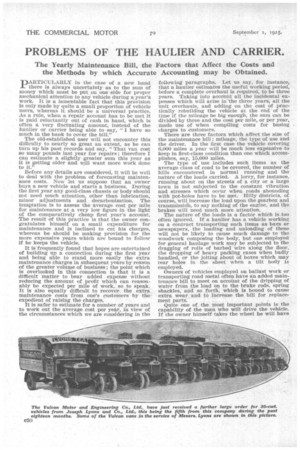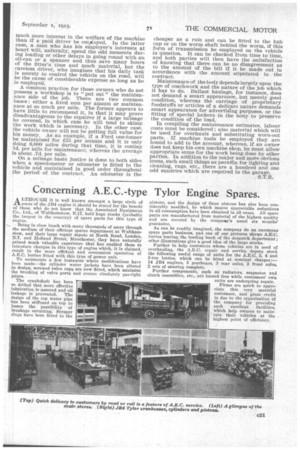PROBLEMS OF THE HAULIER AND CARRIER.
Page 14

Page 15

If you've noticed an error in this article please click here to report it so we can fix it.
The Yearly Maintenance Bill, the Factors that Affect the Costs and the Methods by which Accurate Accounting may be Obtained.
DARTICULARLY in the case of a new hand .1= there is always uncertainty as to the sum of money which must be put on one side for proper mechanical attention to any vehicle during a year's work. It is a lamentable fact that this provision is only made by quite a small proportion of vehicle users, whereas it should be a universal practice. As a rule, when a repair account has to be met it is paid reluctantly out of cash in hand, which is often a very fluctuating amount, instead of the haulier or carrier being able to say, "I have so much in the bank to cover the bill."
The old-established user will not encounter this difficulty to nearly so great an extent, as he can turn up his past records and say, "That van cost so many pounds last year for repairs ; therefore I can estimate a slightly greater sum this year as It is getting older and will want more work done to it."
Before any details are considered, it will be well to deal with the problem of forecasting maintenance costs. :Now let us suppose that an owner buys a new vehicle and starts a business. During the first year any good-class chassis or body should not need much attention, other than lubrication, minor" adjustments and decarbonization. The temptation is to assess the average cost per mile for maintenance at a very low figure in the light of the comparatively cheap first year's account. The result • of this practice is that the owner congratulates himself on a small expenditure for maintenance and is inclined to cut his charges, whereas he should be making provision for the more expensive years which are bound to follow if he keeps the vehicle.
It is frequently found that hopes are entertained of building up a connection during the first year and being able to stand more easily the extra maintenance charges in subsequent years by reason of the greater volume of business ; the point which is overlooked In this connection is that it is a difficult matter to bear added expense without reducing the amount of Profit which can reasonably be expected per mile of Work, so to speak, It is also equally difficult to recover the extra maintenance costs from one's customers by the expedient of raising the charges.
It is safer to estimate for a number of years and to work out the average cost per year, in view of the circumstances which we are considering in the following paragraphs. Let us say, for instance, that a haulier estimates the useful working period, before a complete overhaul is required, to be three years. Taking into acconnt all the incidental expenses which will arise in the three years, all the unit overhauls, and adding on the cost of practically rebuilding the vehicle at the end of the time if the mileage be big enough, the sum can be divided by three and the cost per mile, or per year, Made use of when compiling costs for basing charges to customers. There are three factors which affect the size of the maintenance bill : mileage, the type of use and the driver. In the first case the vehicle covering *3,000 miles a year will be much less expensive to keep in first-class condition than one which accomplishes, say, 15,000 miles. The type of use includes such items as the average class of road to be covered, the number of hills encountered in normal running and the nature of the loads carried. A lorry, for instance, running about on the streets of a city or a large town is not subjected to the constant vibration and stresses which occur when roads abounding with Pot-holes have to be met. Hilly districts, of course, will increase the load upon the gearbox and transmission, to say nothing of the engine, and the brakes will need much more attention.
The nature of the loads is a facter will& is too often ignored. If a haulier has a vehicle working on a contract transporting such items as bags or newspapers, the loading and unloading of these will not be likely to canse much damage to the woodwork composing the body, but one employed for general haulage work may be subjected to the dragging of rolls of barbed wire along the floor, the dropping of heavy packing cases when badly handled, or the jolting about of boxes which may tear holes in the sheet when a tilt body is employed. Owners of vehicles employed on ballast work or transporting road metal often have an added maintenance bill to meet on accoimt of the dripping of Water from the load bri to the brake rods, spring shackles, and so forth, which is bound to cause extra wear and to increase the bill for replacement parts: Quite one of the most important points is the capability of the man who will drive the vehicle. If the owner himself takes the wheel he will have much more interest in the welfare of the machine than if a paid driver be etnio:oyed. In the latter case, a man who has his employer's interests at heart will, naturally, spend the odd moments during loading or other delays in going round with an oil-can or a spanner and thus save many hours of the fitter's time and much material, but the careless driver„ who imagines that his daily task is merely to control the vehicle on the road, will be the cause of considerable expense so long as he is employed.
A common practice for those owners who do not possess a workshop is to "put out" the maintenance side of the job. There are two common bases : either a fixed sum per annum or maintenance at so much per mile. The former appears to have little to recommend it, in that it may prove disadvantageous to the repairer if a large mileage be covered, in which case he will tend to skimp the work which is necessary. In the other case, the vehicle owner will not be getting full value for his money. As an example, if a Ford one-tonner be maintained for £25 per annum and it is only doing 6,000 miles during that time, it is costing id. per mile for maintenance, whereas the average Is about .7d. per mile.
On a mileage basis justice is done to .both sides when a speedometer or odometer is fitted to the vehicle and maintained in good order throughout the period of the contract. An odometer is the cheaper as a rule and can be fitted to the hub cap or on the worm shaft behind the worm, if this form of transmission be employed on the vehicle in question. It can be checked from time to time, and both parties will then have the satisfaction of knowing that there can be no disagreement as to the amount of the bill if it be made out in accordance with the amount stipulated in the contract.
Maintenance of the body depends largely upon the type of coachwork and the nature of the job which it has to do. Ballast haulage, for instance, does not demand a smart appearance, but merely good condition, whereas the carriage of proprietary foodstuffs or articles of a delicate nature demands smart appearance for advertising purposes, or the fitting of special lockers in the body to preserve the condition of the load.
In compiling the maintenance estimates, labour costs must be considered ; also material which will be used for overhauls and substituting worn-out parts. If machine tools be employed they are bound to add to the account, whereas, if an owner does not keep his own machine shop, he must allow appropriate sums for the work being done by other parties. In addition to the major and more obvious items, such small things as paraffin for lighting and cleaning, rags, etc.' there are a hundred and one odd sundries which are required in the garage.




























